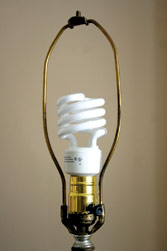Leave it to an energetic teen to inform us there's a catch to those energy-saving, compact-fluorescent light bulbs many of us have switched to: CFLs contain about 5 milligrams of mercury, a potent neurotoxin, says Reynolds High junior Jovahnna "Jojo" Graves. "That's about equal to the tip of your ballpoint pen, and it's in vapor form, which makes it deadlier because it can go directly to your bloodstream."

The 17-year-old is on a mission to get the word out about the toxic gas released when the bulbs break. Graves started looking into CFLs as a project for Venturing — a co-ed program for ages 14-20, sponsored by the Boy Scouts of America. For her project, she researched CFLs, learning about the devices' mercury content, energy-saving qualities and disposal challenges.
Although CFLs reduce CO2 emissions, save energy and last longer than traditional incandescent bulbs, they pose a health risk if not disposed of properly, she learned. In Asheville residents are encouraged to take old CFLs to local fire stations or The Home Depot stores, or mail them to recycling companies.
But the bulbs can break in transit, and many consumers simply toss them in the trash, where they could easily break. (A City of Asheville recycling brochure reminds residents that even vacuuming broken bulbs can spread the gas.) Graves suggests packing old CFLs into the boxes or other containers your replacement bulbs come in. She's also written North Carolina Gov. Bev Perdue, who responded by mentioning her support of a pending state bill, which bans the disposal of CFLs in unlined landfills (H.B. 1287).
Graves, who says she'd like to become a nurse anesthetist like her dad, has taken her CFL-disposal campaign to the Shriners Club and Progressive 880, and has written letters to local and state politicians. She wants to get the word out on television too. She explains that her project could earn her the Scout's Hornaday badge "for distinguished service in natural resource conversation." To earn it, teens and young adults come up with their own projects and set their own goals. Such self-directed efforts are a mainstay of scouting. The project, she says, began with a simple thought: "Mercury's very toxic, and I started wondering why they would put it in light bulbs."
The toxic element is part of what makes CFLs so efficient, she learned, and the amount of mercury they contain is significantly less than, say, an old household thermometer, which could hold thousands of milligrams. Still, mercury is particularly dangerous for children, says Graves. With more and more CFLs being sold every day, we've got to start thinking of how we'll dispose of them.
Inactive dam at Progress Energy gets "poor" rating
A Sept. 15 Environmental Protection Agency report rates the 44 high-hazard, coal-ash impoundments in the United States from "unsatisfactory" to "satisfactory" based on their structural integrity, and one of two Progress Energy dams in Skyland earned the second-lowest rating of "poor." (None of the 44 facilities received an "unsatisfactory.")
The investigation was spurred by a Dec. 2008 dam failure in Kingston, Tenn., that resulted in a spill of more than 5 million cubic yards of toxic coal-ash sludge. EPA and Tennessee Valley Authority officials concluded that one reason the dam failed was that it had been built on old sludge and ash.
The report has raised concern at environmental groups such as the Southern Alliance for Clean Energy, which has issued a call for Progress Energy officials "to immediately ensure that public health and environmental safety are guaranteed at this plant."
Progress Energy spokesperson Drew Elliot responds, "The [EPA] reports confirmed that our active ash ponds are structurally sound, although in the case of the inactive 1964 impoundment, that might not be apparent." That dam no longer holds back an active coal-ash pond: When the company created a new pond and dam in 1982 at the Asheville facility, it drained and filled the older impoundment, which is now the site for a natural-wetlands filtration system used primarily to reduce mercury levels in water discharged from the power plant.
The cause for the low rating comes down primarily to a lack of documentation, Elliot explains: "We were unable to confirm or rule out whether we did or did not build the original dam on ash, slag, etc. since it was built so long ago. … At this point we do not believe that it was built in that manner, since a) both the impoundment and the Asheville Plant itself began operation in 1964; and b) we did not follow such a practice with any of our other dams or ponds."
The older dam will undergo a slope-stability investigation, which will include soil borings and tests to calculate the likelihood of it failing during heavy rains or other extreme weather events, says Eliott. (The Tennessee spill occurred after very wet and extremely cold weather.) He also emphasizes, "The inactive ash impoundment at the Asheville Plant no longer holds water and does not pose a risk of breaching and spilling."
Send your environmental news to mvwilliams@mountainx.com or call 251-1333, ext. 152.



Before you comment
The comments section is here to provide a platform for civil dialogue on the issues we face together as a local community. Xpress is committed to offering this platform for all voices, but when the tone of the discussion gets nasty or strays off topic, we believe many people choose not to participate. Xpress editors are determined to moderate comments to ensure a constructive interchange is maintained. All comments judged not to be in keeping with the spirit of civil discourse will be removed and repeat violators will be banned. See here for our terms of service. Thank you for being part of this effort to promote respectful discussion.